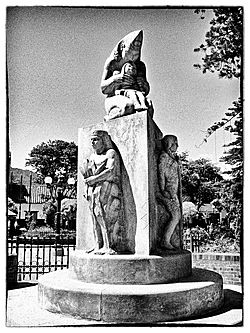Chía (goddess) facts for kids
Quick facts for kids Chía |
|
|---|---|
| Moon | |
| Member of Muisca religion | |

Statue of Chía in Chía
|
|
| Major cult center | Moon Temple, Chía |
| Planet | Moon |
| Region | Altiplano Cundiboyacense |
| Ethnic group | Muisca |
| Consort | Sué (Sun) |
| Greek equivalent | Selene |
| Roman equivalent | Luna |
| Norse equivalent | Máni |
| Slavic equivalent | Devana |
| Hinduism equivalent | Chandra |
The goddess Chía was a very important deity in the Muisca religion. The Muisca people lived in what is now Colombia long before Europeans arrived. Her name comes from the Chibcha language and means "the one who is like the moon."
Chía was worshipped across many Muisca lands. She was seen as a special protector of the Zipa ruler. The Zipa governed the area where the city of Bogotá is today. The main place where Chía was worshipped was in or near the city of Chía, Cundinamarca. This city was named after the goddess herself.
Who Was Chía?
Chía was a central figure in the Muisca group of gods, known as their pantheon. She was often linked to the moon. The Muisca people believed she had many important roles.
The Moon Goddess
As the moon goddess, Chía was connected to the night sky. The moon was very important to the Muisca. It helped them track time and seasons. This was crucial for their farming and ceremonies.
Chía and the Muisca Rulers
Chía was seen as the special guardian of the Zipa ruler. The Zipa was a powerful leader of the Muisca people. This connection showed how important Chía was to their society and government. Her main place of worship, the Moon Temple, was in the city named after her.
How Chía Was Worshipped
The Muisca had special priests called chyquys. These priests were in charge of the sacred calendar. They led the ceremonies for the goddess Chía. During these ceremonies, people would offer valuable items. These offerings included beautiful gold pieces and ceramic artwork.
See also
 In Spanish: Chía (mitología) para niños
In Spanish: Chía (mitología) para niños

